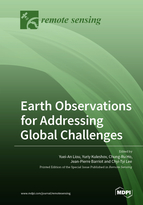Earth Observations for Addressing Global Challenges
A special issue of Remote Sensing (ISSN 2072-4292).
Deadline for manuscript submissions: closed (31 March 2019) | Viewed by 64881
Special Issue Editors
2. Taiwan Group on Earth Observations, Hsinchu, Taiwan
Interests: remote sensing; atmospheric science; environmental monitoring; disaster analysis
Special Issues, Collections and Topics in MDPI journals
Interests: planetary exploration; planetary geodesy; radio science
Special Issues, Collections and Topics in MDPI journals
Interests: remote sensing; physical oceanography; global change; satellite oceanography
Special Issues, Collections and Topics in MDPI journals
Interests: climatology of severe weather phenomena (tropical cyclones, thunderstorms and lightning); climate monitoring and prediction; satellite remote sensing for climate monitoring
Special Issues, Collections and Topics in MDPI journals
Interests: engineering geology; earthquake geology; geostatistics; GIS
Special Issues, Collections and Topics in MDPI journals
Special Issue Information
Dear Colleagues,
As climate changes have been of great concern worldwide for years, addressing these global climate challenges is the most significant task for humanity; thus, Group on Earth Observations (GEO) has launched initiatives across multiple societal benefit areas (agriculture, biodiversity, climate, disasters, ecosystems, energy, health, water, and weather), such as the Global Forest Observations Initiative, the GEO Carbon and GHG Initiative, the GEO Biodiversity Observation Network, the GEO Blue Planet, and so on. Related topics have been addressed and deliberated throughout the world. This Special Issue aims to bring up discussion concerning innovative techniques/approaches based on remote sensing data, and to nurture the knowledge on the acquisition of Earth observations and its applications in the contemporary practice of sustainable development. Research scientists and other subject matter experts are encouraged to submit challenging papers that describe advances in the related topics:
- Disasters
- Health
- Energy
- Climate
- Water
- Weather
- Ecosystems
- Agriculture/Forestry/Fishery
- Biodiversity
- Industry and Policy
Dr. Yuei-An Liou
Dr. Chyi-Tyi Lee
Dr. Yuriy Kuleshov
Dr. Jean-Pierre Barriot
Dr. Chung-Ru Ho
Guest Editors
Manuscript Submission Information
Manuscripts should be submitted online at www.mdpi.com by registering and logging in to this website. Once you are registered, click here to go to the submission form. Manuscripts can be submitted until the deadline. All submissions that pass pre-check are peer-reviewed. Accepted papers will be published continuously in the journal (as soon as accepted) and will be listed together on the special issue website. Research articles, review articles as well as short communications are invited. For planned papers, a title and short abstract (about 100 words) can be sent to the Editorial Office for announcement on this website.
Submitted manuscripts should not have been published previously, nor be under consideration for publication elsewhere (except conference proceedings papers). All manuscripts are thoroughly refereed through a single-blind peer-review process. A guide for authors and other relevant information for submission of manuscripts is available on the Instructions for Authors page. Remote Sensing is an international peer-reviewed open access semimonthly journal published by MDPI.
Please visit the Instructions for Authors page before submitting a manuscript. The Article Processing Charge (APC) for publication in this open access journal is 2700 CHF (Swiss Francs). Submitted papers should be well formatted and use good English. Authors may use MDPI's English editing service prior to publication or during author revisions.








